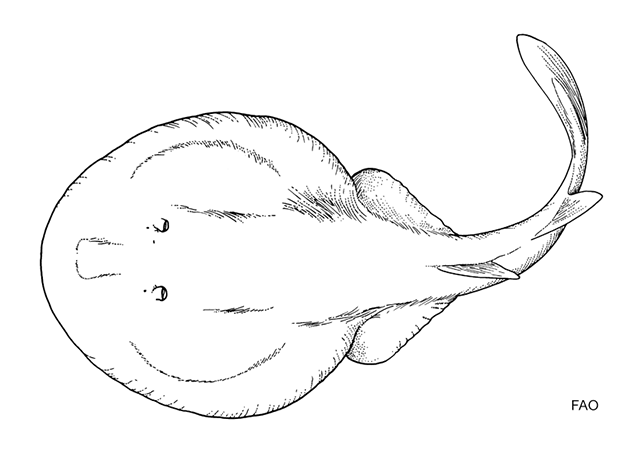| Narcinidae (Numbfishes) |
| 50 cm WD (male/unsexed) |
|
bathydemersal; marine; depth range 200 - 923 m |
| Western Central Atlantic. South Carolina, USA to northern Cuba. |
|
Narrow protractile mouth. Caudal is oval shape. Greater length of head anterior to spiracles, union of margins of its pelvic fins to their tips with the sides of the tail. Soft body and skin (Ref. 6902). Light brown to yellowish-brown dorsal color pattern; white to yellowish-white ventral color pattern, sometimes with distinct yellow markings on posterior ventral disc surface, ventral pelvic fin area, and around mouth. Caudal fin length much less than 1/2 length of tail, roughly equal to 1/5 length of tail; relatively more pronounced upper and lower lobes with lower strongly convex. Distance between dorsal and caudal fins about equal to distance between first and second dorsal fins. Snout relatively short, generally less than 1/3 in disc-length (24% of disc length in 43.5 cm TL female, 25% in 48.5 cm TL), but never much greater than 1/3 as in B. moresbyi (ca 40% in lectotype); disc more rounded, not as elongated as in B. moresbyi (Ref. 48493). |
| Inhabits neritic waters, on sandy bottoms (Ref. 557). Found on continental and insular slopes at 250-1,000 m depths; adults apparently at greatest depths (Ref. 114953). Solitary. Tiny eyes are covered with skin so that the species is blind (Ref. 557). Feeds on marine invertebrates. Both ovaries are functional in an adult female, with numerous small oocytes of ca. 2 mm in thin-walled uteri. Maturity size of males at ca. 16 cm TL; birth size at 8-9 cm TL (Ref. 114953). |
|
Least Concern (LC); Date assessed: 19 June 2019 Ref. (130435)
|
| other |
Source and more info: www.fishbase.org. For personal, classroom, and other internal use only. Not for publication.

